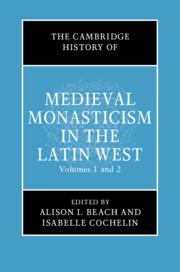Book contents
- The Cambridge History of Medieval Monasticism in the Latin WEST
- The New Cambridge History of Medieval Monasticism in the Latin West
- The Cambridge History of Medieval Monasticism in the Latin WEST
- Copyright page
- Contents
- Figures
- Contributors
- Acknowledgments
- Abbreviations
- 1 General Introduction
- Part I The Origins of Christian Monasticism to the Eighth Century
- 2 The Monastic Laboratory: Perspectives of Research in Late Antique and Early Medieval Monasticism
- 3 Re-Reading Monastic Traditions: Monks and Nuns, East and West, from the Origins to c. 750
- 4 The Archaeology of the Earliest Monasteries
- 5 Egyptian Nuns in Late Antiquity as Exemplars
- 6 Psalmody and Prayer in Early Monasticism
- 7 Heterodoxy and Monasticism around the Mediterranean Sea
- 8 The Invention of Western Monastic Literature: Texts and Communities
- 9 Monastic Rules (Fourth to Ninth Century)
- 10 Social Plurality and Monastic Diversity in Late Antique Hispania (Sixth to Eighth Century)
- 11 Female House Ascetics from the Fourth to the Twelfth Century
- 12 The Archaeology of the Earliest Monasteries in Italy and France (Second Half of the Fourth Century to the Eighth Century)
- 13 Nuns and Monks at Work: Equality or Distinction between the Sexes? A Study of Frankish Monasteries from the Sixth to the Tenth Century
- 14 Ascetic Prayer for the Dead in the Early Medieval West
- 15 Monastic Identity in Early Medieval Ireland
- 16 Constructing Monastic Space in the Early and Central Medieval West (Fifth to Twelfth Century)
- 17 The Economy of Byzantine Monasteries
- Part II The Carolingians to the Eleventh Century
- Part III The Long Twelfth Century
- Part IV Forms of Monasticism in the Late Middle Ages
- Index
- References
14 - Ascetic Prayer for the Dead in the Early Medieval West
from Part I - The Origins of Christian Monasticism to the Eighth Century
Published online by Cambridge University Press: 16 January 2020
- The Cambridge History of Medieval Monasticism in the Latin WEST
- The New Cambridge History of Medieval Monasticism in the Latin West
- The Cambridge History of Medieval Monasticism in the Latin WEST
- Copyright page
- Contents
- Figures
- Contributors
- Acknowledgments
- Abbreviations
- 1 General Introduction
- Part I The Origins of Christian Monasticism to the Eighth Century
- 2 The Monastic Laboratory: Perspectives of Research in Late Antique and Early Medieval Monasticism
- 3 Re-Reading Monastic Traditions: Monks and Nuns, East and West, from the Origins to c. 750
- 4 The Archaeology of the Earliest Monasteries
- 5 Egyptian Nuns in Late Antiquity as Exemplars
- 6 Psalmody and Prayer in Early Monasticism
- 7 Heterodoxy and Monasticism around the Mediterranean Sea
- 8 The Invention of Western Monastic Literature: Texts and Communities
- 9 Monastic Rules (Fourth to Ninth Century)
- 10 Social Plurality and Monastic Diversity in Late Antique Hispania (Sixth to Eighth Century)
- 11 Female House Ascetics from the Fourth to the Twelfth Century
- 12 The Archaeology of the Earliest Monasteries in Italy and France (Second Half of the Fourth Century to the Eighth Century)
- 13 Nuns and Monks at Work: Equality or Distinction between the Sexes? A Study of Frankish Monasteries from the Sixth to the Tenth Century
- 14 Ascetic Prayer for the Dead in the Early Medieval West
- 15 Monastic Identity in Early Medieval Ireland
- 16 Constructing Monastic Space in the Early and Central Medieval West (Fifth to Twelfth Century)
- 17 The Economy of Byzantine Monasteries
- Part II The Carolingians to the Eleventh Century
- Part III The Long Twelfth Century
- Part IV Forms of Monasticism in the Late Middle Ages
- Index
- References
Summary
Despite the common association of monasteries with intercession in the early Middle Ages, the religious, cultural, and social practice of prayer extended beyond the narrow ascetic–monastic sphere. In keeping with both Old Testament and early Christian traditions, prayer was understood as an expression of brotherly love that was the duty of all Christians, and not as the exclusive obligation of a few ascetic specialists. Even when prayer served the primary function of worship, the idea of intercession was at least implied—a functional complementarity reflected in the so-called double command of love: “And thou shalt love the Lord thy God, with thy whole heart, and with thy whole soul, and with thy whole mind, and with thy whole strength. This is the first commandment. And the second is like to it: Thou shalt love thy neighbor as thyself” (Mark 12:30–31). By late antiquity, the charitable dimension of prayer was integral both to ecclesiology and to the development of Christian social concepts.
- Type
- Chapter
- Information
- The Cambridge History of Medieval Monasticism in the Latin West , pp. 278 - 296Publisher: Cambridge University PressPrint publication year: 2020
References
- 1
- Cited by

